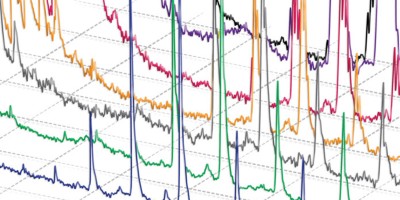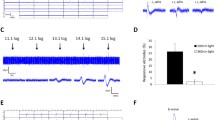Abstract
Cell type–specific green fluorescent protein (GFP) expression in the retina has been achieved in an expanding repertoire of transgenic mouse lines, which are valuable tools for dissecting the retinal circuitry. However, measuring light responses from GFP-labeled cells is challenging because single-photon excitation of GFP easily bleaches photoreceptors. To circumvent this problem, we use two-photon excitation at 920 nm to target GFP-expressing cells, followed by electrophysiological recording of light responses using conventional infrared optics. This protocol offers fast and sensitive detection of GFP while preserving the light sensitivity of the retina, and can be used to obtain light responses and the detailed morphology of a GFP-expressing cell. Targeting of a GFP-expressing neuron takes less than 3 min, and the retina preparation remains light sensitive and suitable for recording for at least 8 h. This protocol can also be applied to study retinal neurons labeled with other two photon–excitable fluorophores. It is assumed that potential users of this protocol will have a basic understanding of retinal physiology and patch-clamp recording, which are not described in detail here.



Similar content being viewed by others
References
Münch, T. et al. Approach sensitivity in the retina processed by a multifunctional neural circuit. Nat. Neurosci. 12, 1308–1316 (2009).
Huberman, A.D. et al. Genetic identification of an On–Off direction-selective retinal ganglion cell subtype reveals a layer-specific subcortical map of posterior motion. Neuron 62, 327–334 (2009).
Dedek, K. et al. A novel type of interplexiform amacrine cell in the mouse retina. Eur. J. Neurosci. 30, 217–228 (2009).
Chen, M., Weng, S., Deng, Q., Xu, Z. & He, S. Physiological properties of direction-selective ganglion cells in early postnatal and adult mouse retina. J. Physiol. (London) 587, 819–828 (2009).
Van Wyk, M., Wässle, H. & Taylor, W.R. Receptive field properties of ON- and OFF-ganglion cells in the mouse retina. Vis. Neurosci. 26, 1–12 (2009).
Huberman, A.D. et al. Architecture and activity-mediated refinement of axonal projections from a mosaic of genetically identified retinal ganglion cells. Neuron 59, 425–438 (2008).
Kim, I.-J., Zhang, Y., Meister, M. & Sanes, J.R. Laminar restriction of retinal ganglion cell dendrites and axons: subtype-specific developmental patterns revealed with transgenic markers. J. Neurosci. 30, 1452–1462 (2010).
Kim, I.-J., Zhang, Y., Yamagata, M., Meister, M. & Sanes, J.R. Molecular identification of a retinal cell type that responds to upward motion. Nature 452, 478–482 (2008).
Siegert, S. et al. Genetic address book for retinal cell types. Nat. Neurosci. 12, 1197–1204 (2009).
Yonehara, K. et al. Expression of SPIG1 reveals development of a retinal ganglion cell subtype projecting to the medial terminal nucleus in the mouse. PLoS ONE 3, e1533 (2008).
Dhingra, A. et al. Probing neurochemical structure and function of retinal ON bipolar cells with a transgenic mouse. J. Comp. Neurol. 510, 484–496 (2008).
Xu, C., Zipfel, W., Shear, J.B., Williams, R.M. & Webb, W.W. Multiphoton fluorescence excitation: new spectral windows for biological nonlinear microscopy. Proc. Natl Acad. Sci. USA 93, 10763–10768 (1996).
Euler, T. et al. Eyecup scope—optical recordings of light stimulus-evoked fluorescence signals in the retina. Pflugers Arch. 457, 1393–1414 (2009).
Euler, T., Detwiler, P.B. & Denk, W. Directionally selective calcium signals in dendrites of starburst amacrine cells. Nature 418, 845–852 (2002).
Huckfeldt, R.M., et al. Transient neurites of retinal horizontal cells exhibit columnar tiling via homotypic interactions. Nat. Neurosci. 12 35–43 (2009).
Mumm, J.S. et al. In vivo imaging reveals dendritic targeting of laminated afferents by zebrafish retinal ganglion cells. Neuron 52, 609–621 (2006).
Schroeter, E.H., Wong, R.O.L. & Gregg, R.G. In vivo development of retinal ON-bipolar cell axonal terminals visualized in nyx∷MYFP transgenic zebrafish. Vis. Neurosci. 23, 833–843 (2006).
Morgan, J., Huckfeldt, R.M. & Wong, R.O.-L. Imaging techniques in retinal research. Exp. Eye Res. 80, 297–306 (2005).
Majewska, A., Yiu, G. & Yuste, R. A custom-made two-photon microscope and deconvolution system. Pflugers Arch. 441, 398–408 (2000).
Kerschensteiner, D. et al. Genetic control of circuit function: Vsx1 and Irx5 transcription factors regulate contrast adaptation in the mouse retina. J. Neurosci. 28, 2342–2352 (2008).
Pelli, D.G. The Video ToolBox software for visual psychophysics: transforming numbers into movies. Spat. Vis. 10, 437–442 (1997).
Brainard, D.H. The Psychophysics Toolbox. Spat. Vis. 10, 433–436 (1997).
Sakmann, B. & Neher, E. Geometric Parameters of Pipettes and Membrane Patches 637–645 (Plenum Press, 1983).
The Axon Guide: A Guide to Electrophysiology & Biophysics Laboratory Techniques 3rd edn, 27–84 (MDS Analytical Technologies, 2008).
Perkins, K.L. Cell-attached voltage-clamp and current-clamp recording and stimulation techniques in brain slices. J. Neurosci. Methods 154, 1–18 (2006).
Acknowledgements
We thank R. Eifert at Cold Spring Harbor Laboratory for the OLED holder schematics, and J. LeDue at the University of California, Berkeley for optical assistance. Support was contributed by NIH Grants RO1EY013528 and RO1EY019498.
Author information
Authors and Affiliations
Contributions
W.W. was involved in conducting the experiments and preparing the article. J.E. assisted in conducting the experiments, wrote the visual stimulation and analysis code, constructed Figure 1a and assisted in writing the article. M.B.F. was involved in the experimental design and assisted in the preparation of the article.
Corresponding author
Ethics declarations
Competing interests
The authors declare no competing financial interests.
Rights and permissions
About this article
Cite this article
Wei, W., Elstrott, J. & Feller, M. Two-photon targeted recording of GFP-expressing neurons for light responses and live-cell imaging in the mouse retina. Nat Protoc 5, 1347–1352 (2010). https://doi.org/10.1038/nprot.2010.106
Published:
Issue Date:
DOI: https://doi.org/10.1038/nprot.2010.106
- Springer Nature Limited
This article is cited by
-
Micelle-enabled self-assembly of porous and monolithic carbon membranes for bioelectronic interfaces
Nature Nanotechnology (2021)
-
Linear and nonlinear chromatic integration in the mouse retina
Nature Communications (2021)
-
Pan-retinal characterisation of Light Responses from Ganglion Cells in the Developing Mouse Retina
Scientific Reports (2017)
-
Retinal origin of direction selectivity in the superior colliculus
Nature Neuroscience (2017)
-
Electrical synapses convey orientation selectivity in the mouse retina
Nature Communications (2017)




